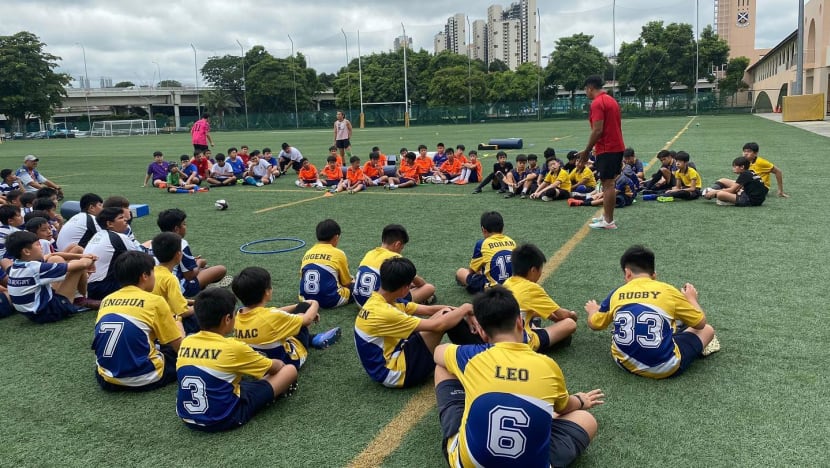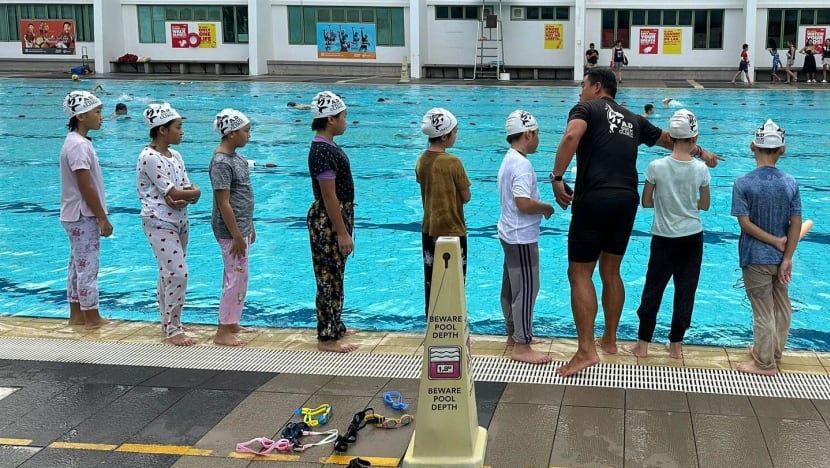How do coaches tell if a young athlete is seriously ill or simply exhausted?
The untimely death of a Singapore Sports School student has raised questions around training protocols.

Young athletes participating in a Singapore Rugby Union event in March 2023. (Photo: Facebook/Singapore Rugby)

This audio is generated by an AI tool.
SINGAPORE: The death of a Singapore Sports school student has surfaced questions around protocols when junior athletes feel unwell, and whether it's possible to distinguish between serious illness and plain tiredness.
Badminton student-athlete Pranav Madhaik's coach was fired after an investigation found safety lapses.
The 14-year-old had told his coach that he was feeling unwell following a time trial in October. The coach told him to rest, then left the school without checking on the student.
WHEN STUDENTS REPORT SICK
Coaches CNA spoke to highlighted the steps they take when a young charge reports feeling unwell.
Swimming instructor Andy Ding said the standard operating procedure or SOP kicks in even before the start of any physical activity, with parents informing coaches if their children had been sick prior.
They will need to submit medical certificates or clearance for their children to participate in lessons.
Coaches also ask the students if any of them had fallen ill recently, and do a visual check for signs of weakness or tiredness, said Mr Ding, whose ADSwimClinic provides private lessons to those aged three to 13.
“If they tell us or show signs of exhaustion, we have to stop them and (allow them to rest) accordingly to let them recover first before assessing and allowing them to continue,” the 41-year-old added.
“We do not push them over the limit when we know that they are not able to take it. We have to gradually pace them and monitor them accordingly.”
Coaches will then inform the child's parents.
In group classes, administrative staff and parents are around to keep an eye on the children and attend to them.
“We need extra manpower to be on standby in case of any medical (emergencies) or accidents,” Mr Ding said.

In schools, if students are not feeling well and the symptoms persist, they are brought to the general office or a recovery area, said former physical education (PE) teacher and rugby coach Sidney Kumar.
“We do that so that there’s an extra set of eyes monitoring the kid because sometimes teachers need to rush for other lessons and deal with the other 30, 35 kids,” said Mr Kumar, who is now general manager of the Singapore Rugby Union, the national association for the sport.
Teachers will then check in on students to see if they have recovered. If that's not the case, the student will be allowed to go home.
Either way, parents will be kept informed "straight away", whether through a phone call or text message, said Mr Kumar.
Both Mr Kumar and Mr Ding also highlighted that all coaches - whether at school or club level - must be first-aid trained.
The National Registry of Coaches - which ensures baseline qualifications among other coaching standards - stipulates that its members must hold first aid certification, including in cardiopulmonary resuscitation (CPR) and automated external defibrillator (AED) use.
DETECTING EMERGENCIES
There are noticeable signs when a child is going through something requiring more urgent attention, said Mr Ding.
For example, they will appear restless; very silent with less movement; or look pale with their lips turning purple or pale-white.
“All these are general symptoms and signs that coaches are actually trained to spot,” Mr Ding said.
He added that experienced coaches who see the same children regularly would find it easier to spot anything amiss.
“You know their style and whether they can take it or not," said Mr Ding. “Unless it’s an extreme, extraordinary medical condition that even experts can’t tell.”
Mr Kumar said the first step is knowing each student's medical background.
At the school where the 37-year-old previously worked, PE teachers and coaches would run through the medical histories of students at the start of every term, checking for anyone with pre-existing conditions such as asthma.
For Singapore Sports School student Pranav, his cause of death was declared as cardiac arrest with antecedent cause of congenital malformation of coronary vessels.
CNA understands that the condition was not detected during a medical examination Sports School student-athletes are required to undergo, as part of admission requirements.
The exam includes tests of the cardiovascular system, pulmonary system, neurology assessment, musculoskeletal examination and laboratory tests such as urinalysis, full blood count, ECG and chest X-ray.
Student-athletes must also be certified fit for physical training by a sports doctor.
Mr Ding has encountered parents who do not declare their child’s medical condition either because it happened a long time ago with no relapses, or they were unaware to begin with.
In any case, coaches will pay “special" attention to those with underlying medical conditions, and also seriously consider if they are able to handle certain activities. Training programmes will then be adjusted to ensure that they can keep up.
Asked if anything could be improved in light of Pranav's death, Mr Ding suggested training coaches to better react to situations such as a student suffering from a common condition like asthma.
“Because you will never know. One fine day if it happens to you and you can’t do anything, you lose one life,” he said.
















